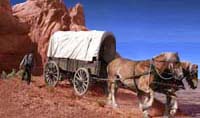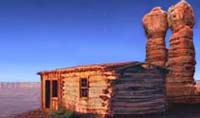 Return to Biography Selections
Return to Biography Selections |
 Download a Printable
Download a Printable
PDF File |
Caleb Haight
Born: 22 May 1856; Cedar City, Iron, Utah
Died: 22 November 1932; Los Angeles, Los Angeles, California
Married: Sarah Ellen Chatterley (“Nellie”); 24 June 1891
Father: Isaac Chauncey Haight
Mother: Eliza Ann Snyder
Early Years
At the time of Caleb Haight’s birth, his father, Isaac Chauncey Haight, was a prominent figure in the community of Cedar City, Utah. He was the local stake president, as well as the president of the Iron County Mission. He owned a large home right off main street where three of the five polygamous wives he would eventually have lived with their children. He also had a farm a few miles away that demanded much care and attention. It was into this busy family that Caleb was born on May 22, 1856. He was the last of seven children born to Isaac Haight by his first wife, Eliza Ann Snyder, and was named after his grandfather Haight.
Caleb was a reserved but gentle boy, who only had six years of formal schooling, but developed a lasting love for reading the scriptures whenever he had a moment to himself. He was a gifted and talented musician, and throughout his life surrounded himself with music. He played a wide variety instruments – the guitar, the violin, the trombone, just to name a few – and enjoyed playing with various local bands. He had the remarkable ability to play any song by ear, even if he had only heard the tune once. He also possessed a splendid singing voice and would sing songs such as “Yellow Rose of Texas” and “My Darling Nellie Gray.” When he was grown and had a family of his own, he would spend Thursday evenings at home playing music and singing religious hymns with his wife and children.
Hole-in-the-Rock
The fact that Caleb’s father, Isaac, was involved in the tragedy at Mountain Meadows (a little over a year after Caleb’s birth), combined with the fact that Isaac was living a polygamous lifestyle, made him a wanted man by the US government. Thus for many of Caleb’s growing-up years, Isaac Haight was gone from his home in Cedar City, in hiding from federal authorities. As the years went by, however, Caleb and his father developed a special bond. In fact, Caleb became a devoted son who spent many years with his father in exile.
In 1879, Isaac Haight was asked by LDS Church authorities to go along with a group of colonizing pioneers headed for the San Juan River. Many of those called to go were from Cedar City, and knew the Haights well. Besides, Isaac was an experienced leader and pioneer himself, and by that time had been pardoned by President Brigham Young for his role in the Mountain Meadows affair and reinstated to full-fellowship within the Church. Nevertheless, he was still a wanted man in the eyes of the law, so his identity was to be kept secret along the way. Caleb, aged 23 and still unmarried, went along with his father as a companion and support. He drove the wagon, in the back of which “was a concealed space where [his] father was comfortable and safe.” In the evenings, Caleb would play music and sing for the tired travelers while many danced along to lift their spirits.
For several years Caleb and his father lived in the San Juan country. They grew to love the harsh beauty of the desert that surrounded them, and fought hard with their fellow pioneers to scratch a living out of the dusty earth. They felt safe being amongst such good friends who never betrayed Isaac’s true identity, even to the pages of history. Finally, it was deemed safe for Isaac to return home to Cedar City, and so he and Caleb loaded their wagon and headed home.
Mexico
Unfortunately, the hope of a lasting reunion with their family in Cedar City was not meant to be. Persecution against Isaac began again, and he was forced to leave both for the safety of those he loved, as well as himself. This time, Caleb and his father headed for the Mormon colonies in Chihuahua, Mexico, where they stayed until Isaac’s death.
Marriage and Family Life
When his father died in 1886, Caleb was finally reunited with his mother and family in Cedar City. There he met a young lady named Sarah Ellen Chatterley (called “Nellie” by her closest associates), and in time the two were married on June 24, 1891. The young couple moved into Isaac Haight’s old home in Cedar City, and it was there that their first two children – daughters Kathleen and Cora – were born. The family then moved to Boulderville, and Caleb found employment in the mines. Not long after, they also began a homestead of their own on forty acres of property. Caleb planted wheat and some fruit trees, while Nellie tended the hogs, cows and chickens. She also kept a beehive and found success harvesting the honey the bees produced, which she then traded for goods the family needed. Their family was growing fast, both in numbers and in years. Three more children were born to Caleb and Nellie while they lived out on the farm – Arthur, Sarah, and Isaac Chauncey. All seemed well, but farming was a hard life and soon Caleb became weary of it. He purchased a 2.5 acre lot in Cedar City and moved his family off the farm. He built them a small frame house in which to live, and returned to working in the mines during the winter months; in the spring he hired out to sheer sheep. A last daughter, named Lillian Bell, joined the family in 1902.
Some years later, Nellie convinced Caleb to once again try farm life. Their daughter Cora had married and moved to Orderville, and at Nellie’s insistence, Caleb and his sons headed in that direction. Their wagon was loaded down with lumber intended for building a new home. However, “when the boys saw the place they refused to stay there. So they unloaded the lumber and went back to Cedar City.”
California
Caleb and Nellie’s son Arthur served in World War I, and after his return home in 1919, the Haight family keenly felt the economic effects of the war. Work was scarce in Cedar City, and so Caleb, his sons, and two of his sons-in-law went to Los Angeles in search of employment. At first they had a difficult time even finding housing, let alone work. But after pooling their resources, and trading in their car, they were able to buy a two-story home into which the three families eventually all moved. Caleb and his sons got jobs at Goodyear Rubber Company, while his sons-in-law found employment as carpenters. Unfortunately, Caleb’s work in the rubber factory took its toll on his health. He developed asthma and had to quit his job. To keep busy, he helped around the house as best he could and was responsible for all the family’s grocery shopping and for tending the garden. He found pleasure in looking after the yard, as he had always “loved beautiful things.” However, his health continued to decline as a result of his asthma and on November 22, 1932 he passed away.
Researched and written for the Hole-in-the-Rock Foundation by:
C.S.M. Jones LLC, Family Heritage Consulting.
Bibliography
Trimmer, Kathleen. “History of Caleb Haight.” Unpublished manuscript from the files of the Daughters of Utah Pioneers, Salt Lake City, Utah.
Woolley, Caroline Keturah Parry. I Would to God: A Personal History of Isaac Haight. Edited by Blanche Cox Clegg and Janet Burton. Cedar City, UT: Southern Utah University Press, 2009.
Caroline Keturah Parry Woolley, I Would to God: A Personal History of Isaac Haight, ed. by Blanche Cox Clegg and Janet Burton (Cedar City, Utah: Southern Utah University Press, 2009), 163.
Kathleen Trimmer, “History of Caleb Haight,” Unpublished manuscript from the files of the Daughters of Utah Pioneers, Salt Lake City, Utah, 2.
|



